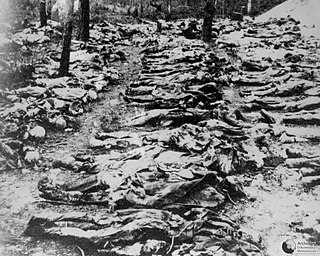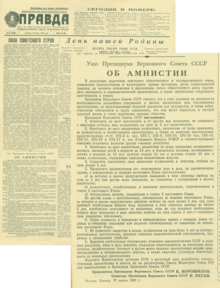
Vsevolod Nikolayevich (Boris) Merkulov was the head of NKGB from February to July 1941, and again from April 1943 to March 1946. He was a leading member of what was later derisively described as the "Beria gang".
The Law of Spikelets or Law of Three Spikelets was a decree in the Soviet Union to protect state property of kolkhozes —especially the grain they produced—from theft, largely by desperate peasants during the Soviet famine of 1932–33. The decree was also known as the "Seven Eighths Law", because the date in Russian is filled into forms as 7/8/1932. The law provided a severe punishment for stolen collective and cooperative property: "execution with confiscation of all property and replacement in mitigating circumstances with imprisonment for at least 10 years with confiscation of all property." Amnesty was prohibited in these cases.
Oleg Nikolayevich Trubachyov was a Soviet and Russian linguist. A researcher of the etymology of Slavic languages and Slavic onomastics, specialist in historical linguistics and lexicographer. He was a Doctor of Sciences in Philological Sciences, an academician of the Russian Academy of Sciences and served as the editor-in-chief of the Etimologiya yearbook. His works are on the etymology of Slavic languages and on East Slavic onomastics.
The Norilsk uprising was a major strike by Gulag inmates in Gorlag, a MVD special camp for political prisoners, and later in the two camps of Norillag [ITL], Norilsk, USSR, now Russia, in the summer of 1953, shortly after Joseph Stalin's death. About 70% of inmates were Ukrainians, some of whom had been sentenced for 25 years because of MGB accusations of being involved in the "Bandera standard". It was the first major revolt within the Gulag system in 1953–1954, although earlier numerous cases of unrest in Gulag camps are known. It was led by Pavel Frenkiel in 1st camp, by Boris Shamaev in 3rd camp, by Yevhen Hrytsyak in 4th camp, by Pavel Filnev in 5th camp and by Lesya Zelenska in 6th camp.

Anti-Katyn is a denialism campaign intended to reduce and obscure the significance of the Katyn massacre of 1940 — where approximately 22,000 Polish officers were murdered by the Soviet NKVD on the orders of Joseph Stalin — by referencing the deaths from disease of thousands of Imperial Russian and Red Army soldiers at Polish internment camps during the Interwar period.

Dinar was a 10th-century Georgian princess of the Bagrationi dynasty of Tao-Klarjeti and Queen regnant of Hereti. She is venerated as a saint. The Georgian Orthodox Church commemorates her on June 30.
Nikolai Vasilyevich Rumyantsev was a Soviet author of several polemics on the history of Christianity, translator. He was also a member of the Soviet circle "Atheist" and the League of Militant Atheists. In the 1920s Rumyantsev was one of the leading proponents of the so-called mythological school in the Soviet academia. He authored such publications, as "The Pre-Christian Christ", "The Pagan Christs – the Ancient Precursors of Christianity", "The Apocalypse – The Revelation of John" and "Orthodox Holidays, Their Origin and Class Essence" (1936). "The Apocalypse – The Revelation of John" was published under the influence of Abram Ranovich. In that publication Rumyantsev, while not explicitly retracting his earlier opinions, offered a study of early Christianity which stressed not its derivation from supposed ancient mythology, but its intrinsic relation to revolutionary, messianic elements in contemporary Judaism.

Kievan Rus' law or law of Kievan Rus', also known as old Russian law or early Russian law, was a legal system in Kievan Rus', in later Rus' principalities, and in the Grand Duchy of Lithuania from the 13th century. Its main sources were early Slavic customary law and Zakon Russkiy, which was partly written in Rus'–Byzantine Treaties. A number of articles have similarities with the Germanic (barbarian) laws, for example, the "Salic law" – a collection of legislative acts of Francia, the oldest text of which dates back to the beginning of the 6th century. The main written sources were Russkaya Pravda and Statutes of Lithuania.

Yuriy Ivanovich Semenov was a Soviet and Russian historian, philosopher, ethnologist, anthropologist, expert on the history of philosophy, history of primitive society, and the theory of knowledge. He was also the original creator of the globally-formation (relay-stadial) concept of world history and is a Doctor of Philosophy, Doctor of Historical Sciences (1963), and Professor. He was Distinguished Professor at the Moscow Institute of Physics and Technology.
Fedor Maksimovich Putintsev was a Soviet propagandist of atheism and a scientific worker in the study of problems of religion and atheism. He was also a journalist and writer.
Mark Mendelevich Persits was a Soviet propagandist of atheism, a scientific worker in the study of problems of religion and atheism, a writer, and a historian of social thought.

Vladimir Georgievich Vinnichevsky, known as The Urals Monster, was the youngest known Soviet serial killer.
Grigory Dementevich Kostomarov, was a Russian writer, participant of the Great October Socialist Revolution, Doktor Nauk in Historical Sciences, professor, head of the Department of CPSU History at the Academy of Social Sciences at the Central Committee of the CPSU, director of the Institute of CPSU History at the Moscow City Committee of the CPSU. He died in Moscow, was buried at the Novodevichy Cemetery. His wife is Zolotova-Kostomarova Maria Iosifovna, doctor, Doktor Nauk in Medical Sciences, professor. His son is Vitaly Grigorievich Kostomarov.
Maria Sidorovna Butinova, née Dolgonosova, was a Soviet and Russian ethnographer, historian, and religious scholar. As a doctor of historical sciences, she was a specialist in the field of religion of Oceania.
Nikolay Petrovich Krasnikov was active in Soviet academia as a philosopher, historian, and religious scholar.

Vladimir Kapitonovich Nikolsky was a Soviet historian, ethnologist, translator, religious scholar, Doctor of Historical Sciences (1943), and professor.
Oktay Abdulkerim oglu Afandiyev was an Azerbaijani historian, Orientalist, Doctor of Historical Sciences, Professor, Corresponding Member of ANAS and Founder of the Azerbaijan School of Safavid Studies.

Kazan Law Institute is a Higher education institution in Kazan, founded in 1931 to train lawyers. Reorganized in 1952 by joining the Kazan Federal University.
Mikhail Timofeyevich Likhachev was an officer in the Soviet Ministry of State Security (MGB) who led the team of Soviet investigators at the Nuremberg trials of Nazi war criminals, and was executed for his role in fabricating criminal cases against prominent Soviet citizens, including the wartime heads of the Soviet air force.
Galina Stepanovna Nikitina — Soviet lawyer and orientalist, Candidate of Juridical Sciences (1953), Doctor of Historical Sciences (1977), author of the book «The State of Israel» – the first monographic study in Soviet literature of the history and economics of the state of Israel.








